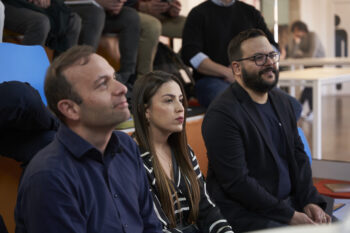In Part One of this three-part series, I gave a brief synopsis of my personal thoughts on intellectual property law. It’s something right out of Kafka.
Part Two of this series explains why intellectual property is so important to tech startups and why we’re all talking about it today.
Most startups participate in the “knowledge economy”, which basically means that instead of making physical objects like computer hardware, automotive engines or pencils, they make tools and services which their customers use to manipulate and disseminate information like text, arrays of numbers, images, movies, et cetera.
The patent system, as it stands today, has a tendency to couch innovations in terms of machinery instead of “ideas”. Allow me to explain. Patent number 2,181,070 is for a “Device for Preventing Pick Outs” for application in agricultural turkey and chicken production. Basically, they’re little goggles one affixes to the fowl’s beak which prevents other members of the flock from pecking out the fowl’s eyes. Cute, right?
But the patent holder, a one M. L. Rudolph, was not granted a patent on the goggles, nor on their lenses or frames. Mr. Rudolph improved on existing “blinder devices”, which “so [obscured] the vision of the fowls as to greatly hamper them in their normal movements about the runways, and to and from nests, roosts, etc.” Mr. Rudolph had the ingenious idea of using transparent colored lenses, which are tinted green to neutralize “flesh-colored and reddish shades”; effectively, he invented protective sunglasses for chickens which renders flesh and blood less enticing, thus preventing cannibalism.
Patents are somewhat inscrutable, so reading them is particularly unsatisfying. Each of the component parts of Mr. Rudolph’s invention are covered under the patent; a rival couldn’t mount the lenses slightly differently and call it a new invention, for example.
Most software patents are, fundamentally, patents on very basic things or variations on basic things. Whereas invention of physical objects had thousands of years of precedent invention to draw upon, software presents a kind of Wild West situation.
Rudolph improved on existing technology and was granted, by dint of the highly-specific nature of his invention, a patent. Most software patents preclude others from improving on their technology, else they face a patent-infringement lawsuit. They are often broad and overly vague.
Here’s the fundamental problem with software patents: they are rights granted to use hunks of language. Software patents are, as the name suggests, for software, which is written in one programming language or another. In this way, we can consider a chunk of code as much a creative feat as it is a technical one, and we have copyright protection for creative work. This prevents outright plagiarism, but still allows the idea or function to be re-articulated elsewhere, perhaps in a manner better than the original.
Software patents are kind of like the government issuing a fiction writer the exclusive right to kill characters so as to evoke emotion.
Apple holds patents on the “slide to unlock” feature, which it uses on its various touch-enabled iDevices. If, after much trial and error, Samsung or HTC discovered that sliding in a curve (kind of like a smiley face) produced a better user experience, and better prevented accidentally activating a phone, say, in the user’s pocket, then it’s just tough luck for them because Apple owns the feature and has a fetish for straight lines.
I mean, am I the only one who thinks this is crazy? Should a company be granted exclusive rights for a whole category of user-interface?
In the case of the company I’ll profile in the final part of this series, patents were issued on commonly implemented technologies. The company’s one novel contribution: the industry it serves. Chicken goggles make more sense than this.
Part Three of this series examines the story of Blackboard Inc, a so-called patent troll of particular odiousness, according to many in the higher education market. It concludes with my evaluation of the America Invents Act.









